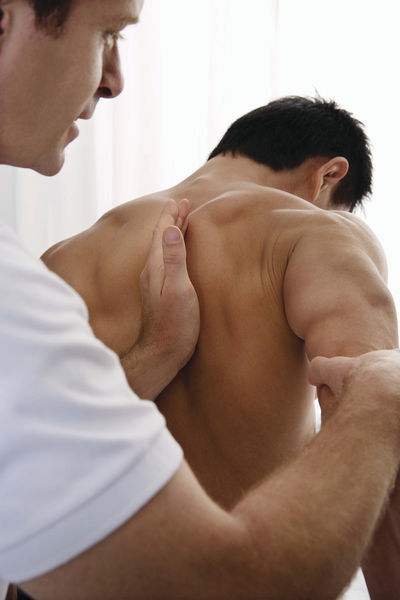Pre-Sport Physicals Keep Young Athletes Safe

Do you have a student-athlete at home?
If so, it’s that time of year again to get them in for their yearly pre-participation physical examination (PPE). The Michigan High School Athletic Association requires athletes to consult with their physician yearly to be declared medically safe to participate in school-sanctioned athletics.
The PPE includes a medical history form which asks about past medical history, family medical history, heart health, and bone/joint conditions. The PPE also include a physical examination from head to toe.
After reviewing the information collected, the physician decides whether the athlete is cleared for all activity, is partially cleared, or should not participate in sport pending additional testing.
There has been a lot of discussion in the athletic medicine community regarding sudden cardiac arrest and sudden cardiac death (SCD) in student athletes. These conditions may be caused by several underlying conditions:
— Hypertrophic cardiomyopathy (HCM) is the single most common non-traumatic cause of SCD in young competitive athletes in the United States. Hypertrophic cardiomyopathy is a disease in which the heart walls enlarge and thicken, making it harder for the heart to pump blood.
— Anomalous coronary arteries (ACA) are the second most common non-traumatic cause of SCD in young athletes. ACAs occur when the blood vessels that supply blood to the heart are defective.
— Myocarditis, a disease marked by inflammation and damage of the heart muscle, can also cause SCD in young athletes.
— Acute aortic dissection or rupture occurs when a large blood vessel branching off the heart tears, is another well-known cause of SCD in athletes.
I asked Dr. Todd Sheperd, M.D., of Bayside Family Medicine a few questions about cardiovascular screening for PPEs in young athletes:
What are the current recommendations for cardiovascular screening PPEs?
“The ‘sports physical’ is currently recommended for all athletes. The frequency in most settings is yearly starting at middle school age. It should include a complete review of potential symptoms of heart disease (fainting, near fainting or symptoms associated with exercise). In addition, a full review of family history is also important.
Red flags include any family members with a history of sudden death from cardiac cause at young age (generally less than 50 years old) or history of enlarged heart or cardiac rhythm problem. It also felt that the best location of this type of exam is in the clinical office setting rather than the mass physicals as it allows for more complete review of the history and the physical is done in a quieter location designed for an exam (as opposed to the school gym or cafeteria, for example).
Limitations to the history and physical above include the fact that many students won’t have family history, symptoms, or abnormal findings on their exam. With this in mind, some cardiologists and sports medicine providers recommend additional testing (in some cases for all athletes).”
Are there certain individuals who are more susceptible to cardiovascular abnormalities?
“Even in the absence of family history and clinical symptoms, African Americans have increased risk of sudden cardiac death, as do athletes with heritage originating near the Mediterranean region.”
When is further cardiovascular testing such as an EKG or echocardiogram (ECHO) warranted?
“The problem with screening all students with EKG and or ECHO is that 5 percent of the time we see a false-positive. Additionally, both EKG and ECHO testing may miss abnormal findings. Anyone with abnormal historical findings (both symptoms and family history) and physical exam findings should be considered at increased risk and may benefit from additional testing.”
What should a student athlete and their parent do next if an abnormality is found?
“In general, any abnormal findings on physical exam or history should prevent athlete from sports clearance until further testing can be completed. Providers with experience and knowledge in the normal changes associated with exercise (athletes’ hearts can change with exercise in normal patterns) should be involved in the further evaluation to avoid over diagnosis and help confirm the presence of absence of any disease which may increase risk of sudden cardiac death.
Because of the possibility that even with advanced testing some students may still be at risk for sudden cardiac death, the presence of defibrillators (AED) at both practices and games may truly be lifesaving. It is essential that coaches and support staff know basic life support and have rapid access to AED because physicians and athletic trainers are not able to be at all locations to respond to a collapsed athlete.
In sum, a PPE is required of all student-athletes in Michigan. Based on the history and physical examination, a physician can decide if further diagnostic evaluation is warranted. When/if cardiovascular abnormalities are identified, the next step for the physician is to make eligibility and disqualification decisions for athletes, or to refer to a specialist. Screening athletes with EKGs or ECHO remain controversial but improvements in training and criteria continue. Regardless, emergency action plans must be in place and routinely reviewed at any athletic facility and access to AED can be lifesaving.”
Lindsey Griffes is the Athletic Trainer for Petoskey High School and also works at Northern Michigan Sports Medicine Center in Petoskey. She can be reached via e-mail at lgriffes@nmsportmed.com. This information is not to be considered medical advice and is not intended to replace consultation with a qualified medical professional.
Story Credit: http://www.petoskeynews.com/news/health/pre-sport-physicals-keep-young-athletes-safe/article_7ea36bcf-5311-57c7-bbe0-04f0a8599074.html


